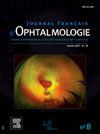飞秒激光LASIK皮瓣提升术后上皮向内生长的发生率
IF 1.1
4区 医学
Q3 OPHTHALMOLOGY
引用次数: 0
摘要
目的评价飞秒LASIK (f-LASIK)皮瓣复位术后上皮向内生长(EI)的发生率。方法:本回顾性病例系列纳入了在加拿大一家独立门诊医疗机构接受屈光增强手术的患者。在2021年7月至2022年12月期间接受过屈光增强手术的18岁及以上患者符合条件。我们排除了有白内障或屈光晶体置换手术史的患者。术后1周、1个月、3个月、6个月、1年随访。主要观察结果是f-LASIK皮瓣移除后EI的发生率。次要结果包括术后12个月的其他并发症和视力结果。结果在纳入的103只眼睛中,41%的患者在随访期间的某个时间点报告了EI,大多数患者在一个月时出现EI,不需要治疗。如果在原始手术后一年内进行增强,EI的发生可能性降低3倍(OR 0.31, P = 0.023),如果在三年后进行增强,EI的发生可能性增加5-6倍(OR = 0.17, P <;0.001)。采用缝合皮瓣提升术(n = 2)和Nd:YAG激光(n = 2)成功治疗EI 4眼。结论只有少数(n = 4) EI皮瓣提升后需要治疗,该手术通常提供良好的长期视力结果。因此,f-LASIK皮瓣提升是一种安全的屈光增强选择,即使是在最初的手术几年后。ObjectifÉvaluer与飞秒激光(f-LASIK)相关的激光侵入率(IE)。在加拿大,本文章由计算机程序翻译,如有差异,请以英文原文为准。
Incidence of epithelial ingrowth following femtosecond laser LASIK flap lifts
Purpose
To evaluate the incidence of epithelial ingrowth (EI) following femtosecond LASIK (f-LASIK) flap relift.
Methods
This retrospective case series enrolled patients who underwent post-refractive enhancement surgery at a single independent outpatient health facility in Canada. Patients 18 years or older who underwent refractive enhancement surgery between July 2021 and December 2022 were eligible. We excluded patients with a history of cataract or refractive lens exchange surgery. Follow-ups were conducted at 1 week, 1 month, 3 months, 6 months, and 1 year postoperatively. The primary outcome was the incidence of EI following f-LASIK flap relifts. Secondary outcomes included other complications and visual outcomes 12 months postoperatively.
Results
Among the 103 included eyes, EI was reported in 41% of patients at some point in the follow-up period, with most EI present at one month and not requiring treatment. EI was three times less likely to develop if the enhancement was performed within one year of the original surgery (OR 0.31, P = 0.023), and was 5–6 times more likely to develop if it was performed after three years (OR = 0.17, P < 0.001). Successful treatment of EI by flap lift with sutures (n = 2) and Nd:YAG laser (n = 2) was performed in 4 eyes.
Conclusions
Only a small number (n = 4) of EI post-flap lifts required treatment, and the procedure generally provided excellent long-term visual outcomes. Thus, f-LASIK flap lift is a safe option for refractive enhancement, even several years following the original surgery.
Objectif
Évaluer l’incidence de l’invasion épithéliale (IE) après un relèvement du volet LASIK au laser femtoseconde (f-LASIK).
Méthodes
Cette série de cas rétrospective a inclus des patients ayant subi une chirurgie de retouche réfractive dans un établissement de santé indépendant au Canada. Les patients âgés de 18 ans et plus ayant subi une retouche réfractive entre juillet 2021 et décembre 2022 étaient éligibles. Les patients ayant des antécédents de chirurgie de la cataracte ou d’échange de cristallin réfractif ont été exclus. Les suivis ont été effectués à 1 semaine, 1 mois, 3 mois, 6 mois et 1 an après l’opération. La mesure principale des résultats était l’incidence de l’IE après le relèvement du volet f-LASIK. Les critères secondaires incluaient d’autres complications et les résultats visuels à long terme (12 mois après l’opération).
Résultats
Parmi les 103 yeux inclus, une IE s’est développée chez 41 % des patients au cours de toute la période de suivi, la plupart des cas apparaissant à un mois et ne nécessitant pas de traitement. L’IE était trois fois moins susceptible de se développer si le relèvement était effectué dans l’année suivant la chirurgie initiale (OR 0,31, p = 0,023), et 5–6 fois plus susceptible de se développer s’il était effectué après trois ans (OR = 0,17, p < 0,001) suivant la chirurgie initiale. Un traitement réussi de l’IE par relèvement du volet avec sutures (n = 2) et laser Nd :YAG (n = 2) a été réalisé sur 4 yeux.
Conclusions de l’étude
Seul un petit nombre (n = 4) de cas d’IE après relèvement du volet ont nécessité un traitement, et la procédure a généralement permis d’obtenir d’excellents résultats visuels à long terme. Ainsi, le relèvement du volet f-LASIK est une option de retouche réfractive sûre, même plusieurs années après la chirurgie initiale.
求助全文
通过发布文献求助,成功后即可免费获取论文全文。
去求助
来源期刊
CiteScore
1.10
自引率
8.30%
发文量
317
审稿时长
49 days
期刊介绍:
The Journal français d''ophtalmologie, official publication of the French Society of Ophthalmology, serves the French Speaking Community by publishing excellent research articles, communications of the French Society of Ophthalmology, in-depth reviews, position papers, letters received by the editor and a rich image bank in each issue. The scientific quality is guaranteed through unbiased peer-review, and the journal is member of the Committee of Publication Ethics (COPE). The editors strongly discourage editorial misconduct and in particular if duplicative text from published sources is identified without proper citation, the submission will not be considered for peer review and returned to the authors or immediately rejected.

 求助内容:
求助内容: 应助结果提醒方式:
应助结果提醒方式:


